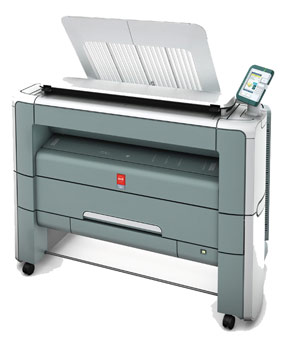It is getting harder to stand out from the crowd in the highly competitive large format monochrome print sector. But with innovative new features and impressive green credentials Océ’s PlotWave 300 is making all the right noises, writes Greg Corke.
With purse strings being tightened, construction professionals need more than just an increase in print throughput to justify investment in a new wide format printer.
Delivering 2.3 A0 sheets per minute, Oce’s PlotWave 300 is certainly productive for an entry-level machine, but the company is also looking at new ways to add value to a product group that hasn’t changed dramatically in the last 10 years.
Single footprint tradeoff
The PlotWave 300 is the first multi-function device from Océ that has a compact, single footprint. This is great for small offices, but there is a trade off when it comes to scanning.
According to Océ, the Contact Image Sensor (CIS) scanner for the PlotWave 300 is slightly less accurate than the standalone models offered in its TDS range. This is because it uses five cameras and stitches the images together, rather than a single camera producing a single image. However, if optimum accuracy is more important than space saving then these single camera scanners are also available as options.
The PlotWave 300 is the first of new generation of large format printers from Océ, which are set to replace the company’s long-standing TDS range over the coming years. Starting at the entry-level with a product targeted at workgroups makes perfect sense, as one of the key design characteristics of the one or two-roll printer is its small footprint. Adding the optional colour scanner does little to add to the bulk as it sits discretely on top of the machine providing true concurrent scanning, printing, and copying without stopping to catch its breath.
Usability has also been a major focus for the new machine and the PlotWave 300 is incredibly easy to operate. It is managed and configured via a browser-based interface and day-to-day functions are accessible via a control panel that is attached to the top right hand corner of the machine. From here one touch scanning and copying is possible from four customisable templates, controlling, for example, resolution, file format and save location or whether it is a colour photo or line drawing to be scanned.
The system also features an innovative stacker, where air is blown between the sheets to stop them sticking together.
A true standalone device
Like all large format multi-function monochrome devices, the PlotWave 300 is networked via ethernet, via LAN or over the web. However, it also includes a unique capability that means it does not have to be connected to a network or even a computer to print or scan drawings. Instead, data can be read in and out using a standard USB memory stick.
This makes it ideal for use on construction sites, where IT infrastructure is often lacking. For example, drawings can be issued at the design office, saved onto memory stick in PDF, HP-GL/2, DWF or TIFF format and brought to site and printed. The system is incredibly easy to use and autosenses the size of the drawing, then scales to fit or auto-rotates to fit the loaded media.
Scanned drawings can also be sent direct to a memory stick. This means users can mark up drawings on site, scan them in colour and then take the data back to the drawing office on a pocket USB drive rather than on rolls of drawings.
For those concerned about security, perhaps the scanning of unauthorised documents, the USB feature can be disabled. The system also includes a feature called electronic shredding, which means any drawings spooled on to its 160GB hard drive are permanently deleted.
Green credentials
No printing technology is ever truly environmentally friendly, but in the PlotWave 300 Océ believes it has one of the ‘greenest’ wide format printers on the market. It features Océ’s radiant fusing technology, which works by heating up ceramic tiles to fuse toner onto plain paper. This technology has been made even more efficient for the PlotWave 300. According to Oce, it has less power demands than its TDS family and consumes 50 percent less power than comparable products in the entry-level segment. It also boasts virtually no ozone emissions due to its catalytic convertor.
Some of these power savings are down to the way the printer heats up and cools down very quickly — a technique that also benefits productivity. From sleep mode, the PlotWave 300 can serve up the first print in under one minute, which is impressive for an LED printer. Renewability is also high on Océ’s list of priorities; with the company claiming 95 percent of the PlotWave 300’s parts can be recycled.
Software
Print jobs can be sent directly from AutoCAD or any Windows-based application and multiple drawing files can be submitted using Océ’s browser-based Publisher Express tool. But to batch submit PDF files via web browser or USB requires additional software.
The whole system is managed from a Web browser using Océ Express WebTools. This includes Job management, monitoring, and network configurations. For print audit, project accounting, and more advanced job submission tools (for other Océ printers and those from other manufacturers), a software solution called Océ Repro Desk Studio comes at an additional cost.
Conclusion
While the PlotWave 300 is certain to get some attention from architectural practices looking for a workhorse monochrome printer to partner their colour inkjets, it’s in the construction sector that Océ’s new large format machine is likely to get the most interest. Simple in its conception, the ability to print from (and scan to) a USB memory stick is certain to attract those looking for a flexible on site solution for print and scan. It’s this, plus the fact that it’s Océ’s greenest wide format LED printers to date, that make the PlotWave 300 stand out from the crowd.






